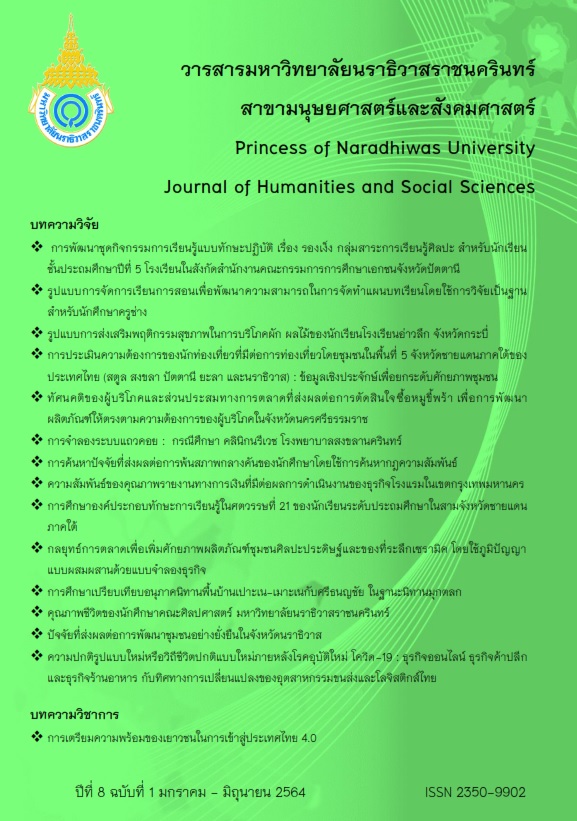A comparative study of motifs in trickery folktales: Pohneh-Mohneh
Main Article Content
Abstract
The present study aims to (1) compare the motifs in the two folktales: Pohneh-Mohneh (Melayu) and Sri Thanonchai (Thai) composed by Prayoon Pisnaka in aspect of common and different characteristics; and (2) analyze and compare their protagonist tricksters based on Stith Thompson’s folklore motif index. The findings are presented in analytical descriptions.
The findings present 4 common motifs: (1) literal interpretations, (2) rewards and punishments, (3) deceptions, and (4) unnatural cruelty. The protagonist tricksters are analytically compared in three dimensions covering (1) status and ways of life, (2) key events, and (3) behaviors. Pokne and Sri Thanonchai are distinctively different. Pokne, living in a farming society, is just a poor, foolish, lazy, and selfish old man who always behave as a liar and deceiver causing conflicts with his wife and his neighbors on everyday life matters. Sri Thanonchai is a handsome and cunning monarchist nobleman who can solve problems ingeniously by his amazing wits, specifically for his own benefits without concerns for others. As a malice, he always confronts the king who, in many cases, loses his face through Sri Thanonchai’s tricky and defying negotiations. With distinctive differences in motifs and main characters, Pokne-Mokne the folktale is not “Sri Thanonchai in the Melayu version” as widely perceived.
Article Details

This work is licensed under a Creative Commons Attribution-NonCommercial-NoDerivatives 4.0 International License.
References
กัญญรัตน์ เวชชศาสตร์. (2541). ศรีธนญชัยในอุษาคเนย์. กรุงเทพฯ: สำนักงานกองทุนสนับสนุนการวิจัย.
คอรีเยาะ เจ๊ะโว๊ะ. (2563, 22 มีนาคม). ผู้ให้ข้อมูลหลัก. [สัมภาษณ์].
ซัมซีเยาะ หะยีบือซา. (2563, 7 มีนาคม). ผู้ให้ข้อมูลหลัก. [สัมภาษณ์].
นุชนาถ เหละดุหวี. (2537). การวิเคราะห์นิทานพื้นบ้านไทยมุสลิม จังหวัดปัตตานี (วิทยานิพนธ์ปริญญาศิลปศาสตรมหาบัณฑิต). มหาวิทยาลัยสงขลานครินทร์, สงขลา.
ประคอง นิมมานเหมินทร์. (2551). นิทานพื้นบ้านศึกษา. (พิมพ์ครั้งที่ 3). กรุงเทพฯ: โครงการเผยแพร่ผลงานวิชาการ คณะอักษรศาสตร์ จุฬาลงกรณ์มหาวิทยาลัย.
ประพนธ์ เรืองณรงค์. (2553). นิทานพื้นบ้านชายแดนใต้. วารสารรูสมิแล, 31(2), 74-76.
ประยูร พิศนาคะ. (2519). ศรีธนญชัยฉบับมาตรฐาน. (พิมพ์ครั้งที่ 3). กรุงเทพฯ: สํานักพิมพ์คลังวิทยา.
ปรานี วงศ์เทศ. (2561). เพศและวัฒนธรรม. (พิมพ์ครั้งที่ 4). กรุงเทพฯ: สำนักพิมพ์นาตาแฮก.
มาหะมะ บินอาแวดอเลาะ. (2563, 14 มีนาคม). ผู้ให้ข้อมูลหลัก. [สัมภาษณ์].
ยุพดี ยศวริศสกุล. (2560). การศึกษานิทานพื้นบ้านมุสลิมในจังหวัดปัตตานี. วารสารวิทยบริการ มหาวิทยาลัยสงขลานครินทร์, 28(3), 185-195.
เรไร ไพรวรรณ์. (2552). วรรณกรรมท้องถิ่น. กรุงเทพฯ: มหาวิทยาลัยราชภัฏธนบุรี.
เรไร ไพรวรรณ์. (2553). คติชนและภูมิปัญญาไทย. กรุงเทพฯ: มหาวิทยาลัยราชภัฏธนบุรี.
ศิราพร ณ ถลาง. (2552). ทฤษฎีคติชนวิทยา : วิธีวิทยาในการวิเคราะห์ตำนาน-นิทานพื้นบ้าน. (พิมพ์ครั้งที่ 2). กรุงเทพฯ: สำนักพิมพ์แห่งจุฬาลงกรณ์มหาวิทยาลัย.
ศิริพร ศรีวรกานต์. (2542). การศึกษาเปรียบเทียบทิลล์ ออยเลนชะปีเกลกับศรีธนญชัย ในฐานะนิทานมุขตลก (วิทยานิพนธ์ปริญญาอักษรศาสตรมหาบัณฑิต). จุฬาลงกรณ์มหาวิทยาลัย, กรุงเทพฯ.
อับดุลรอฮมัน ดอเลาะ. (2563, 8 มีนาคม). ผู้ให้ข้อมูลหลัก. [สัมภาษณ์].
อับดุลฮาลิม แมทาลง. (2563, 15 มีนาคม). ผู้ให้ข้อมูลหลัก. [สัมภาษณ์].
Thompson, S. (1958). Motif-Index of Folk-Literature. Retrieved April 15, 2014, from http://www. ualberta.ca/~urban/Projects/English/Motif_Index.htm.


